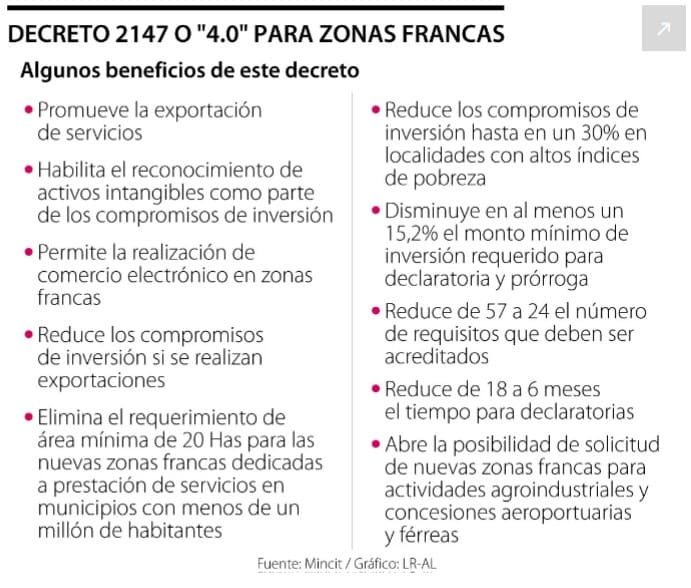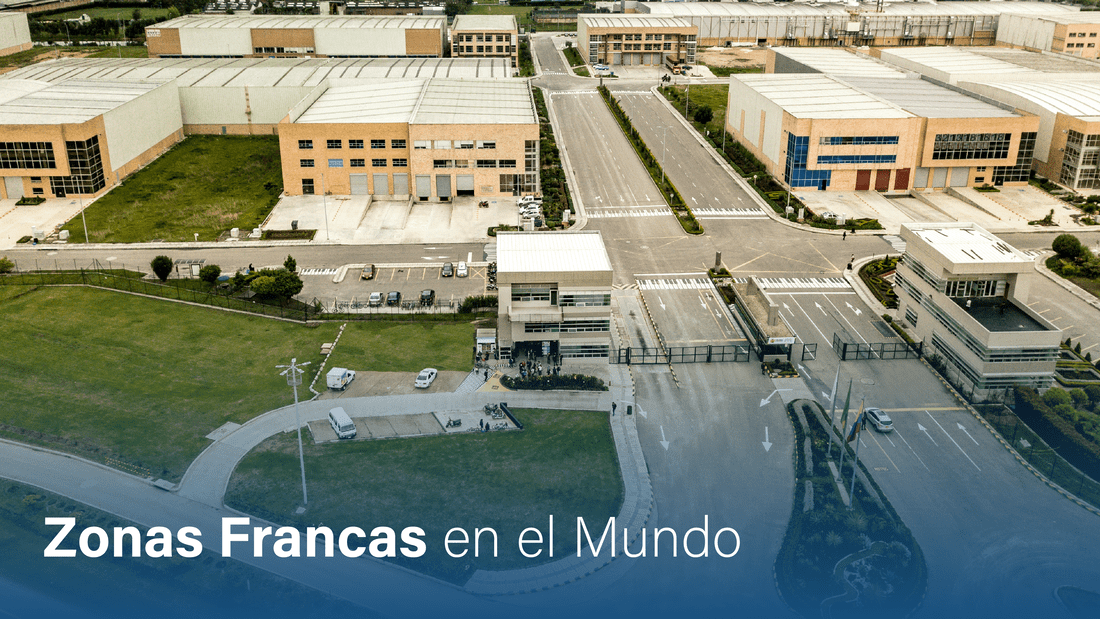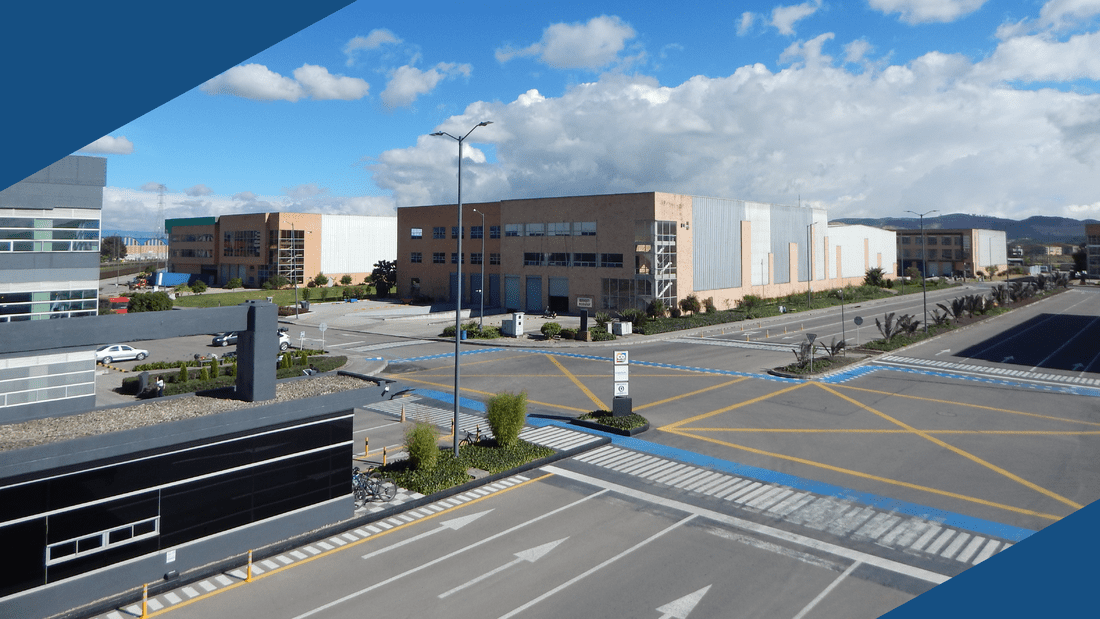Free Trade Zones 4.0 represent a significant evolution in the traditional concept of Free Trade Zones, adopting the latest Industry 4.0 technologies and processes to boost efficiency, productivity and competitiveness in international trade. Free zones became a key driver for economic growth and attracting foreign direct investment in many countries.
In Colombia, they have achieved positive figures at a locomotive pace. Given their good results, the Government wishes to strengthen them and two years ago Decree 279 of 2021 was issued, which at the time was called Free Trade Zones 4.0 and covers the work of trains and airports.
At the time, it was reported that "it improved the mechanisms for the addition and extension of free zone areas and introduced two major figures which are airports and railroads", information that was reported by local media.

Free Trade Zones 4.0 Colombia represent a transformation of the traditional ones, which will take place step by step, to adapt to the needs of the digital and connected economy. They are characterized by their focus on technological innovation, the integration of new technologies and the promotion of Industry 4.0. They leverage cutting-edge industries such as artificial intelligence, Internet of Things, robotics, virtual reality, cybersecurity and other emerging areas.
One of the fundamental characteristics of Colombia's Free Trade Zones 4.0 is their advanced infrastructure. They are equipped with high-speed communication networks, state-of-the-art data centers, intelligent monitoring systems and other tools that allow companies to operate efficiently and take full advantage of the opportunities offered by the digital economy.
They also often have testing environments and research and development laboratories, where companies experiment and develop new technologies and products.
One of the most important aspects of Free Trade Zones 4.0 is the attraction of foreign direct investment (FDI), since they offer a favorable environment for investment, with tax benefits and quality infrastructure. This makes them attractive destinations for multinationals wishing to expand their operations into new markets and take advantage of the competitive advantages offered by these zones. FDI not only contributes to the economic growth of the host country, but also generates employment, boosts technology transfer and promotes the integration of the national economy into global value chains.
Key benefits of Free Zones 4.0
- Improved operational efficiency: As mentioned, Colombia's free trade zones 4.0 focus on the adoption of advanced technologies to optimize production and logistics processes, leading to greater operational efficiency. Companies reduce costs, improve product quality and speed up delivery times.
- Investment attraction: The implementation of free zones 4.0 can be highly attractive to investors. Companies can benefit from tax incentives, such as tax exemptions or reduced tariffs, allowing them to save significant costs. These incentives can attract both domestic and foreign companies to set up operations in FTZs, boosting investment and economic growth.
- Encouraging innovation: Free Trade Zones 4.0 encourage innovation and collaboration among the companies operating in them. Technology is a catalyst for an environment conducive to research and development, as companies gain access to resources they did not have available and establish strategic alliances. This drives the creation of new products and services, as well as the continuous improvement of existing ones.
- Skills development and employment: require a highly skilled workforce. The implementation of technologies increases the training and skills development of workers, which increases employability and raises income levels. In addition, the establishment of companies in free trade zones generates new direct and indirect employment opportunities in the surrounding region.
- Boosting international competitiveness: By adopting advanced technologies and improving operating efficiency, located companies also become stronger to compete internationally. The ability to produce high-quality goods and services more efficiently and at lower cost enables them to better face global competition. This results in increased exports and greater participation in global value chains.
This last point is even more relevant when, according to DANE, in 2022, exports in Colombia reached a historic high of the last nine years, to continue with this dynamic, free zones 4.0 Colombia have the ability to continue supporting everything that has to do with the export sector.
To this must be added the positive purposes to be offered in Colombia through Decree 279 of 2021:

Credits: MinCIT and Diario La República
Transition to Free Zones 4.0
- Understand the concept of Free Trade Zones 4.0: to start this transition, it is essential to have a clear understanding of what a Free Trade Zone 4.0 implies. Colombia, i.e., analyze what is encompassed by adopting advanced technologies to improve efficiency, productivity and quality of processes within the zone.
- Evaluate the existing infrastructure: The next phase is to examine the existing infrastructure in the Free Trade Zone. It is important to determine whether it is equipped to support technologies. This includes a robust communications network, high-speed internet access and an adequate physical structure to house technology equipment.

- Develop a digitalization strategy: once the infrastructure has been evaluated, it is necessary to develop a digitalization strategy that adapts to the needs of consolidating Free Zones 4.0 Colombia. This requires the adoption of integrated management systems, such as the Industrial Internet of Things (IIoT) to improve efficiency and real-time monitoring of processes, as well as leveraging artificial intelligence solutions and data analysis for decision-making based on accurate information.
- Fostering collaboration and innovation: Colombia's Free Trade Zones 4.0 are characterized by fostering collaboration and innovation among the companies operating in them. This is generated through the creation of coworking spaces, the organization of networking events and the promotion of collaboration between companies and research and development centers. Open innovation and the creation of dynamic business ecosystems are key to boosting growth and competitiveness -precisely- in a Free Trade Zone 4.0.
- Training and skills development: The transition to Free Trade Zones 4.0 Colombia will require employees to acquire new skills and knowledge to work with advanced technologies. It is essential to implement training and skills development programs to ensure that employees are prepared to take full advantage of new technological opportunities. This requires training in programming, data analysis, management skills and knowledge of emerging technologies.
- Business promotion and attraction: Once the Free Trade Zone has made the transition to a Free Trade Zone 4.0, it is critical to promote and attract businesses that will benefit from this advanced technological environment. This can be achieved through targeted marketing campaigns, participation in trade shows, and collaboration with government agencies and chambers of commerce to highlight the benefits and opportunities offered by Free Zone 4.0.
- Establish strategic alliances: having alliances with key players in the technology and business sector facilitates the transition to Free Trade Zones 4.0. These alliances have collaboration agreements with technology providers, universities and research centers, as well as with industry-leading companies already operating in the field of Free Zones 4.0. These alliances provide expertise, access to technologies and opportunities for collaboration on joint projects.
- Implementation of adequate regulations and legal framework: it is important to ensure that the legal and regulatory framework is up to date and compatible with 4.0 technologies and business models. This involves reviewing and adapting existing laws and regulations to ensure data protection, cybersecurity and compliance in a digitized environment. In addition, policies and mechanisms must be established to encourage innovation and experimentation in the Free Trade Zone 4.0.
We can say that the transition to FTZ 4.0 involves a number of key steps, from understanding the concept and assessing the existing infrastructure, to developing a digitization strategy, fostering collaboration and innovation, training employees and promoting FTZ 4.0 to attract new businesses.

With the implementation of these measures, take full advantage of advanced technologies and become a highly competitive business environment conducive to economic growth.
From Zona Franca de Occidente, we have always worked to provide the companies that are established with a robust infrastructure in different aspects, for example:
- Underground electrical and telecommunications networks.
- Double ring for power supply at different voltage levels according to users' needs.
- Medium voltage circuits of 11.4 KV and for large energy consumers of 34.5 KV.
- Robust, proprietary substation.
- Solar energy and fiber optic internet project.
In the more than 12 years of experience of Zona Franca Occidente, the knowledge of its human talent and organization allows us to provide advice to organizations according to their specific needs, identifying and taking advantage of the benefits of the free trade regime. Click and contact the experts.






